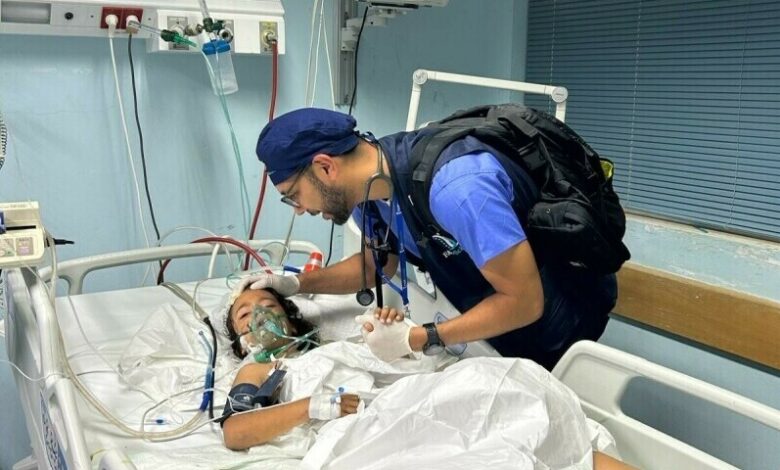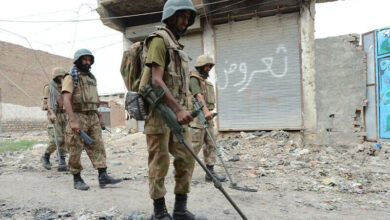Hunger, bombs and perseverance: What this US doctor saw in Gaza as Israel invaded Rafah – Prism

Dr Usman Shah, a Pakistan-origin American doctor, visited Gaza earlier this month as a part of a humanitarian mission and has promised to go back.
Dr Usman Shah, a medical doctor with 10 years of experience, was quite familiar with the sight of blood, but not the sounds of bombs. In Gaza, where bombardment has continued for more than seven months, he found himself stopping in his tracks and frantically looking around any time he heard an explosion. The children of Gaza, he recalled, were unfazed.
“During my rounds of the hospital, I saw several children playing outside in camps … the echo of bombs always jolted me. But these kids kept playing as if the sound of explosions was second nature to them,” he told Dawn.com.
Dr Shah, a pulmonary and critical care expert, was in Gaza as part of a medical team for nearly three weeks, but he saw more children inside the hospital with missing limbs than outside playing in the rubble.
“There were so many children, most under the age of six, coming in with burns from the bombings,” he said. “So many of them had over 60 per cent burns and despite tireless efforts, we couldn’t save them from the infections.”
The doctor particularly remembers three children, all under the age of five, who were brought to the hospital with burn injuries. Two of them were orphans. “The mother of the third child, a girl, was waiting outside as we tried to resuscitate the children,” he recalled.
None of them survived.
Some of the children Dr Shah treated had half their bodies missing. “Seeing that, especially when it is children, is very traumatising,” he said, adding that the healthcare system was unable to handle such complexity of patients because they all came together and in multiple numbers.
Children account for more than one in three of the 36,550 people killed in Israel’s seven-month-long assault on Gaza, according to the Palestinian health ministry. Thousands more, both young and elderly, have suffered severe injuries, which have often times required amputations.
Healthcare system on the brink
Born in Pakistan and raised in Florida, Dr Shah, 43, was among the 17 British, American and African doctors who visited Gaza earlier this month as a part of a medical mission. For three weeks in April and May — on behalf of a non-profit organisation — he worked at the European General Hospital in Khan Younis, which was desperately short of everything except badly wounded patients.
The day he entered the Strip through the Egyptian border, the doctor was confronted with hunger, rubble and the perpetual buzzing of drones. But also in the midst of the destruction was the ‘I Love Gaza’ sign, situated at the entrance to the crossing in eastern Rafah, which was later run over by an Israeli tank.
Dr Shah stayed at a guest house that night, located in an area declared a “green zone” by the Israeli military.
“The next morning, as we drove towards the hospital, we saw bombed buildings, lots of camps and tents, and dishevelled people on the streets. There is no sewage system or clean water,” he recalled.
On reaching the medical facility, the group split into several teams. Dr Shah made his way towards the intensive care unit, where his expertise lay, and was introduced to the staff — all Palestinians.
“When I got a tour of the ICU, I was shocked to find that there was a dire shortage of supplies. The censors on the ventilators/respirators were not working which made them dangerous to use. These ventilators could not be fixed because they were old and needed repairs.
“Due to this, all the ventilators caught a bacteria called Acinetobacter, so if you were on the ventilator for more than a day, you would get pneumonia. A lot of these patients ended up dying,” he said.
Dr Shah recounts his experience calmly, the same way he treats his patients. But every day he spent in Gaza, there was the persistent pressure of deciding who could be saved and who was beyond hope. Patients with open wounds lay on the hospital floors, surrounded by blood and flies, the air filled with the cries of grieving families.
“I saw a lot of patients with shrapnel injuries … when the shrapnel hit their body, it was sometimes so strong that it would enter their organs i.e. brain and lungs, and caused trauma.”
“There are not enough resources or staff that can take care of them at once.”
There is no erasing such horrors even if you are a highly-trained doctor with over 10 years of experience.
Fear of safety
Dr Shah exited Gaza on May 17, a day he recalls as one of the most difficult in his life.
“With foreign doctors at the hospital, our patients and the local staff felt safe because they believed the Israeli authorities wouldn’t attack the facility with us being there,” Dr Shah recalled.
The doctor was scared that with his mission’s departure, it would be easier to target the hospital. “We are scared for the staff, the patients and their families.”
The fear of being attacked is the same for the Palestinians and the humanitarians alike. When in Gaza, Dr Shah and his colleagues coordinated all their movements with the United Nations Office for the Coordination of Humanitarian Affairs and the World Health Organisation (WHO) as the organisations were in touch with the Israeli authorities.
Every day in the enclave, Dr Shah felt the bombing inching closer.
“We used to sleep in a nursing college dorm. The bombing would mostly happen at night … we could hear drones, jets, tanks and sometimes even gunfire. Our windows and drawers would shake, waking us up,” he said.
On such nights, the ambulances would go towards the bombing, and if they found injured persons, the ambulances would come back with sirens. Dr Shah and other doctors at the European General Hospital waited for the survivors.
Sometimes, the ambulances never returned. Other times, they came back with some survivors, who were barely alive. “More than half of these people ended up dying in the emergency rooms or ICUs,” he added.
Unwavering faith
Despite these conditions, the American doctor described Palestinians as the most resilient people he had ever met. During the seven months of bombing, hunger and devastation, there is one thing that they have held on to very firmly: Tawakkul — believe in God.
“At the hospital, I met a doctor who had lost his wife and daughter while he was caring for others’ wounds; their house was bombed. That man still came back to work after burying his family, and resumed saving lives,” he recalled.
This was not just the story of one Palestinian. Every nurse or doctor Shah met had lost at least one member of their family.
“But their faith was so strong that they were always content. Never have I heard anyone say ‘Alhamdulillah’ (praise be to God) more than the people of Gaza,” the doctor told Dawn.com. “They have this inherent belief that their family members who were killed are martyrs and they take comfort in knowing that.”
The Palestinians in the Strip have had to leave their homes and live in tents, they have been displaced not once but multiple times, from one camp to the other. “They don’t feel secure because the bombing is following them wherever they are,” Dr Shah said.
Regardless, most Gazans don’t want to leave the Strip. This is their home and they want to rebuild it.
But of course, wars and conflicts can take a toll on even the strongest of individuals.
“The few people who want to leave are those with young children and sick family members. But they have to pay a significant price, apart from leaving their land, at the Egyptian border which ranges between $5,000 to $10,000.
“Most people cannot afford it,” the doctor said.
He recalled that several attempts were made to transfer critical patients to Egypt but the approvals were rare. There is a system in place for patients who need to undergo complex procedures and they have to apply for a transfer to Egypt. But the process goes through multiple channels including the United Nations, WHO and Israeli authorities.
“While the doctors nominate patients who need to be transferred for complex surgeries, the final decision lies with Israel and Egypt,” Dr Shah told Dawn.com, adding that during his time in Gaza, none of such applications were approved.
Hunger and malnutrition
Dr Shah and his fellow humanitarians brought a total of 100 bags of luggage along with them to Gaza; it was the only way they could bring medical equipment, food supplies and other aid into the enclave.
But soon they realised that this was barely adequate for the needs of the Strip; hunger and malnutrition were plaguing Gaza.
Earlier this month, the WHO warned of a “full-blown” famine in the enclave. Around 30pc children below the age of two are reported to be acutely malnourished while 70pc of the population in northern Gaza is facing “catastrophic hunger”, according to the United Nations.
“When I met Palestinian doctors at the hospital, I immediately noticed how skinny and malnourished they were. This was the staff, not the patients … you could see their cheekbones, their arms had no muscle, their eyes were sunken.
“You could tell they had lost a lot of weight in a glance as their scrubs won’t fit anymore,” he told Dawn.com.
In his conversations with fellow Palestinian doctors and nurses over the weeks, Dr Shah found that they had been living on one meal a day. On average, a person should be consuming around 2,000 calories in a day, but the doctor suspected that Gazans were just getting around 400 to 800 calories.
Many members of the visiting team too lost around 10 to 15 pounds during their three weeks in Gaza.
For those outside the corridors of the hospital, the situation was much worse.
The families of most of the local doctors and nurses were living in camps outside the hospital, the American doctor said. “The sewage system there was horrible … they didn’t have running water or functional washrooms. A single bathroom was shared by around 500 people.”
“You could smell sewage around the tent area, which was very close to their water pump. It is likely that the water was infected,” Shah said, adding that these sanitary conditions were giving rise to cases of Hepatitis A.
After the Israeli assault on the Rafah crossing on May 7, humanitarian aid coming into the Strip was blocked. Till the time of Dr Shah’s departure on May 17, it had not been resumed.
“The aid on the US-built pier is not reaching to the people in Gaza. People are dying of starvation, lack of equipment, lack of sanitation … there is so much death and destruction we are seeing due to the lack of humanitarian aid.
“As a doctor, I believe we can bring a lot of surgical equipment — but the most important thing they need is clean water and nutrition because their immune systems are very weak. Without clean water they will be vulnerable to infections and dehydration,” Dr Shah stressed.
He warned that the mortality numbers will double, if not triple, if the humanitarian corridors are not opened.
All photos provided by Dr Usman Shah
Source link


